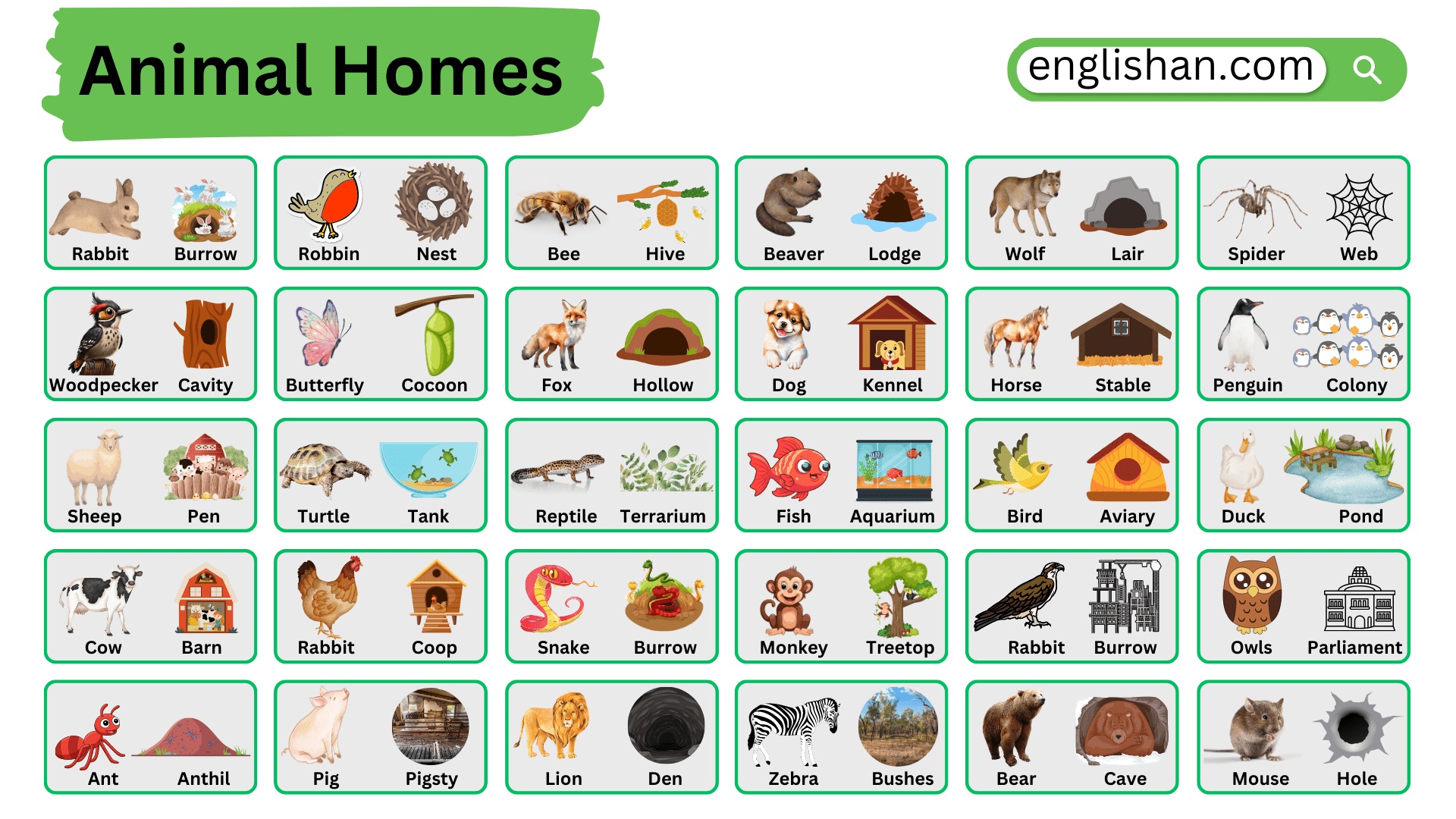Contents
Learning plants names in English is helpful when discussing nature and its beauty. Each plant, from tiny herbs to towering trees, has its own specific name that helps people understand more about them. Whether you’re talking about a flower in your garden or a tree in the park, using the right plant name connects us to nature in a meaningful way. Knowing these names makes it easier to talk about plants, share gardening tips, and appreciate the many forms of life around us. Plants names offer a deeper insight into the world of greenery.
Flowers Plants Names

Rose
A beautiful flowering plant known for its fragrant blooms and thorny stems. Available in various colors, roses are often used in landscaping, perfumery, and medicinal products. Size varies depending on the species.

Tulip
Famous for its bright, cup-shaped flowers, tulips bloom in spring and are widely cultivated for gardens and floral arrangements. They grow up to 60 cm tall and are known for symbolizing love and new beginnings.

Sunflower
Tall plants with large, bright yellow flowers and edible seeds. Sunflowers grow up to 3 meters high and are often used for oil production and as a food source. They are a symbol of adoration.

Lily
Lilies are tall perennials with large, showy flowers. Known for their fragrance, they are popular in bouquets and gardens. Lilies symbolize purity and come in a variety of species and colors.

Carnation
A popular cut flower, carnations have ruffled, fragrant blooms in many colors. They grow up to 80 cm tall and are often used in floral arrangements. Carnations symbolize fascination and love.

Jasmine
Jasmine is a fragrant flowering plant often used in perfumes and teas. Its small white or yellow flowers bloom in clusters. Jasmine symbolizes love and beauty, and the plant can grow as a shrub or vine.

Orchid
Known for their exotic, intricate flowers, orchids come in a wide range of colors and forms. They are often used in floral arrangements and symbolize beauty, love, and strength. Orchids require specific care for optimal growth.

Daffodil
A cheerful spring bloomer with bright yellow or white trumpet-shaped flowers. Daffodils grow about 40 cm tall and symbolize rebirth and new beginnings. They are often used in gardens and floral displays.

Marigold
Marigolds are vibrant orange or yellow flowers often used for decoration and medicinal purposes. These hardy plants grow up to 90 cm tall and symbolize passion and creativity.

Lavender
Lavender is a fragrant herb with purple flowers used in aromatherapy, essential oils, and cooking. It grows in bushy clumps up to 1 meter tall and symbolizes calm and serenity.

Hibiscus
Hibiscus plants produce large, colorful flowers and are often used in teas and beauty products. They can grow as shrubs or small trees and are known for their tropical beauty. Hibiscus symbolizes delicate beauty.

Iris
With its striking, colorful blooms, the iris is a popular garden plant. It grows up to 90 cm tall and is known for symbolizing wisdom and courage. Irises are often used in perfumes and landscaping.

Geranium
Geraniums are hardy, colorful flowering plants that are often grown in gardens or pots. They bloom in various colors and are known for their medicinal and ornamental uses. Geraniums symbolize friendship and comfort.

Peony
Peonies are known for their large, fragrant blooms in shades of pink, red, and white. Often used in wedding bouquets, they symbolize romance and prosperity. Peony plants can grow up to 1.5 meters tall.

Chrysanthemum
Chrysanthemums, or “mums,” are popular autumn flowers with a wide range of colors and sizes. They symbolize longevity and joy. Often used in floral arrangements and gardens, they can grow up to 1 meter tall.

Poppy
Poppies are known for their vibrant, cup-shaped flowers and are often used in remembrance symbols. They grow up to 1 meter tall and are known for their medicinal uses in pain relief and their association with sleep.

Daisy
A classic flower, daisies have a bright yellow center and white petals. They are symbols of innocence and purity and are often used in gardens and floral arrangements. Daisies grow up to 60 cm tall.

Begonia
Begonias are versatile plants known for their colorful flowers and attractive foliage. They are often used in gardens, hanging baskets, and as houseplants. Begonias grow up to 60 cm tall and symbolize caution.

Petunia
Petunias are popular garden flowers known for their bright, trumpet-shaped blooms in a variety of colors. They grow up to 45 cm tall and symbolize resilience and anger.

Zinnia
Zinnias are bright, daisy-like flowers that bloom in a range of vibrant colors. They grow up to 1 meter tall and are known for their hardiness. Zinnias symbolize endurance and lasting affection.

Azalea
Azaleas are flowering shrubs with vibrant blooms in shades of pink, red, and white. They are often used in landscaping and symbolize temperance and passion. Azaleas grow up to 2 meters tall.

Pansy
Pansies are small, colorful flowers often used in gardens and containers. They grow up to 23 cm tall and symbolize thoughtfulness and remembrance. Pansies are known for their heart-shaped petals.

Gardenia
Gardenias are known for their fragrant white flowers and glossy green leaves. Often used in perfumes, they symbolize purity and love. These shrubs can grow up to 1.8 meters tall.

Lilac
Lilacs are fragrant shrubs with clusters of small purple or white flowers. They grow up to 6 meters tall and symbolize renewal and confidence. Lilacs are commonly used in perfumes and landscaping.

Camellia
Camellias are evergreen shrubs with glossy leaves and large, rose-like flowers. They bloom in winter and early spring, symbolizing admiration and perfection. Camellias grow up to 6 meters tall.

Hydrangea
Hydrangeas are known for their large, globe-like clusters of flowers that change color based on soil acidity. They symbolize gratitude and are commonly used in gardens and floral arrangements. They grow up to 3 meters tall.

Magnolia
Magnolias are large flowering trees with fragrant, white, pink, or purple blooms. They are known for their beauty and symbolize dignity and perseverance. Magnolias can grow up to 25 meters tall.
Flower Plants in Single Picture

Herbs and Medicinal Plants

Aloe Vera
A succulent plant known for its soothing, healing properties. Aloe vera grows up to 100 cm tall and is often used in skincare products and for treating burns. It is also valued for its medicinal gel.

Mint
A fragrant herb that grows up to 60 cm tall, mint is widely used in teas, cooking, and medicines. It is known for its refreshing scent and digestive benefits. Mint is often grown in gardens for its easy propagation.

Sage
Sage is a woody herb with silver-green leaves, known for its earthy aroma. It grows up to 70 cm tall and is used in cooking, traditional medicine, and rituals. Sage is often linked to wisdom and healing.

Thyme
A small, aromatic herb that grows up to 40 cm tall, thyme is popular in cooking and medicinal uses. Known for its antimicrobial properties, it’s often used to treat respiratory issues and add flavor to dishes.

Basil
Basil is an herb that grows up to 60 cm tall and is often used in culinary dishes like pesto and salads. Known for its fragrant leaves, it also has medicinal uses, particularly for reducing inflammation.

Oregano
A robust herb growing up to 50 cm tall, oregano is a key ingredient in Mediterranean cuisine. Its strong flavor is used in cooking, and it’s known for its antioxidant and anti-inflammatory properties.

Chamomile
A small flowering plant growing up to 30 cm tall, chamomile is known for its calming effects and is often used in teas. It’s also used in skin care for its anti-inflammatory properties.

Eucalyptus
A fast-growing tree that can reach up to 60 meters, eucalyptus is known for its aromatic leaves, used in essential oils for treating colds and respiratory issues. It’s also a common ingredient in ointments and lozenges.

Lemon Balm
A fragrant herb that grows up to 70 cm tall, lemon balm is known for its calming effects and is often used in teas. It’s also believed to improve mood and cognitive function.

Lemon Grass
This tall, fragrant grass grows up to 1.5 meters tall and is commonly used in cooking, particularly in Southeast Asian dishes. It’s also used in herbal teas and as a natural mosquito repellent.

Yarrow
A flowering plant that grows up to 90 cm tall, yarrow is known for its medicinal uses in wound healing and reducing inflammation. It’s often used in traditional herbal remedies for its astringent properties.

Bay Leaf
Bay leaves come from a tree that grows up to 18 meters tall. Known for their use in cooking, they add a subtle flavor to soups and stews. Bay leaves also have digestive and anti-inflammatory benefits.

Fennel
Fennel is a tall herb growing up to 2 meters, known for its feathery leaves and anise-like flavor. It’s used in cooking and for its digestive and antioxidant properties.

Calendula
A flowering plant growing up to 60 cm tall, calendula is known for its bright orange blooms. It’s commonly used in skin care products for its anti-inflammatory and healing properties.

Comfrey
Comfrey grows up to 1.2 meters tall and is known for its medicinal uses, especially in treating wounds and inflammation. Its leaves and roots are often used in herbal poultices.

John’s Wort
St. John’s Wort grows up to 1 meter tall and is known for its bright yellow flowers. It’s widely used in herbal medicine for treating mild depression and wounds.

Arnica
Arnica is a flowering plant growing up to 60 cm tall, known for its pain-relieving properties. It’s often used in topical creams to reduce bruising, swelling, and muscle soreness.

Catnip
A member of the mint family, catnip grows up to 100 cm tall and is known for its effects on cats. It’s also used in teas and herbal remedies for its calming effects on humans.

Valerian
Valerian grows up to 1.5 meters tall and is known for its calming properties, often used in teas and supplements to improve sleep and reduce anxiety. Its root has a distinctive earthy smell.

Ginseng
Ginseng is a slow-growing plant known for its root, which is used to boost energy, reduce stress, and improve cognitive function. It grows up to 60 cm tall and is widely used in traditional medicine.

Black Cohosh
This tall plant, growing up to 2.5 meters, is known for its use in treating menopausal symptoms. It’s often used in herbal remedies to balance hormones and relieve hot flashes.

Elderberry
Elderberry grows up to 6 meters tall and is known for its immune-boosting properties. Its berries are often used in syrups and teas to treat colds and flu.

Garlic
Garlic is a bulbous plant that grows up to 60 cm tall and is known for its strong flavor and medicinal properties. It’s widely used in cooking and is valued for its ability to boost the immune system.

Ginger
A flowering plant known for its knobby root, ginger grows up to 1 meter tall and is used in cooking and medicine. It’s particularly known for easing nausea and digestive issues.

Cilantro
Cilantro is a leafy herb that grows up to 60 cm tall and is widely used in cooking. It’s known for its fresh, citrusy flavor and is commonly used in cuisines around the world.

Parsley
Parsley is a leafy herb that grows up to 30 cm tall and is known for its fresh, slightly peppery flavor. It’s commonly used as a garnish and is rich in vitamins A and C.

Rosemary
Rosemary is an evergreen shrub that grows up to 1.5 meters tall and is known for its fragrant leaves. It’s often used in cooking and has medicinal properties that improve memory and digestion.

Tarragon
A perennial herb that grows up to 90 cm tall, tarragon is known for its licorice-like flavor. It’s commonly used in French cuisine and has medicinal uses for digestive health.

Dill
Dill grows up to 1 meter tall and is known for its feathery leaves and aromatic flavor. It’s commonly used in pickling and has digestive benefits.

Marjoram
A fragrant herb that grows up to 60 cm tall, marjoram is closely related to oregano and is often used in Mediterranean cooking. It’s also known for its calming effects and digestive benefits.

Turmeric
Turmeric is a bright orange root that grows up to 1 meter tall. Known for its anti-inflammatory properties, it’s used in cooking and traditional medicine, particularly in treating arthritis.

Peppermint
Peppermint is a hybrid plant that grows up to 60 cm tall and is known for its cooling, refreshing taste. It’s widely used in teas, candies, and for digestive health.

Saffron
Saffron comes from the crocus flower and is known for its vibrant color and unique flavor. It’s one of the most expensive spices in the world and is commonly used in cooking and traditional medicine.

Chives
Chives are a member of the onion family and grow up to 30 cm tall. They are used in cooking for their mild onion flavor and are known for their high vitamin content.

Lovage
Lovage is a tall herb growing up to 2 meters and is known for its celery-like flavor. It’s commonly used in soups and stews and has medicinal uses for digestive health.

Fenugreek
Fenugreek is an herb that grows up to 60 cm tall, known for its slightly bitter seeds used in cooking and traditional medicine. It’s often used to boost milk production and improve digestion.
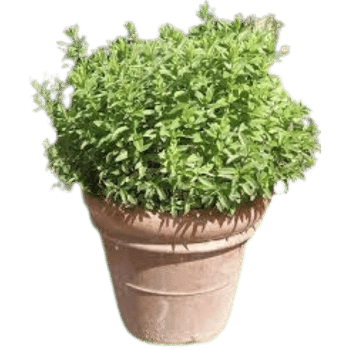
Spearmint
Spearmint is a fragrant herb that grows up to 90 cm tall and is widely used in teas, cooking, and dental products. It’s known for its milder flavor compared to peppermint and has digestive benefits.

Lemongrass
A tall, fragrant grass that grows up to 1.5 meters, lemongrass is used in Southeast Asian cooking and herbal teas. It’s also known for its antibacterial properties and is commonly used in aromatherapy.

Holy Basil
Holy basil is a sacred plant in Indian culture, growing up to 60 cm tall. Known for its adaptogenic properties, it’s used in herbal medicine to reduce stress and boost the immune system.

Dandelion
Dandelion is a hardy plant that grows up to 30 cm tall, known for its yellow flowers and medicinal uses. It’s commonly used in teas and salads and is valued for its detoxifying properties.
Herbs and Medicinal Plants in Single Picture
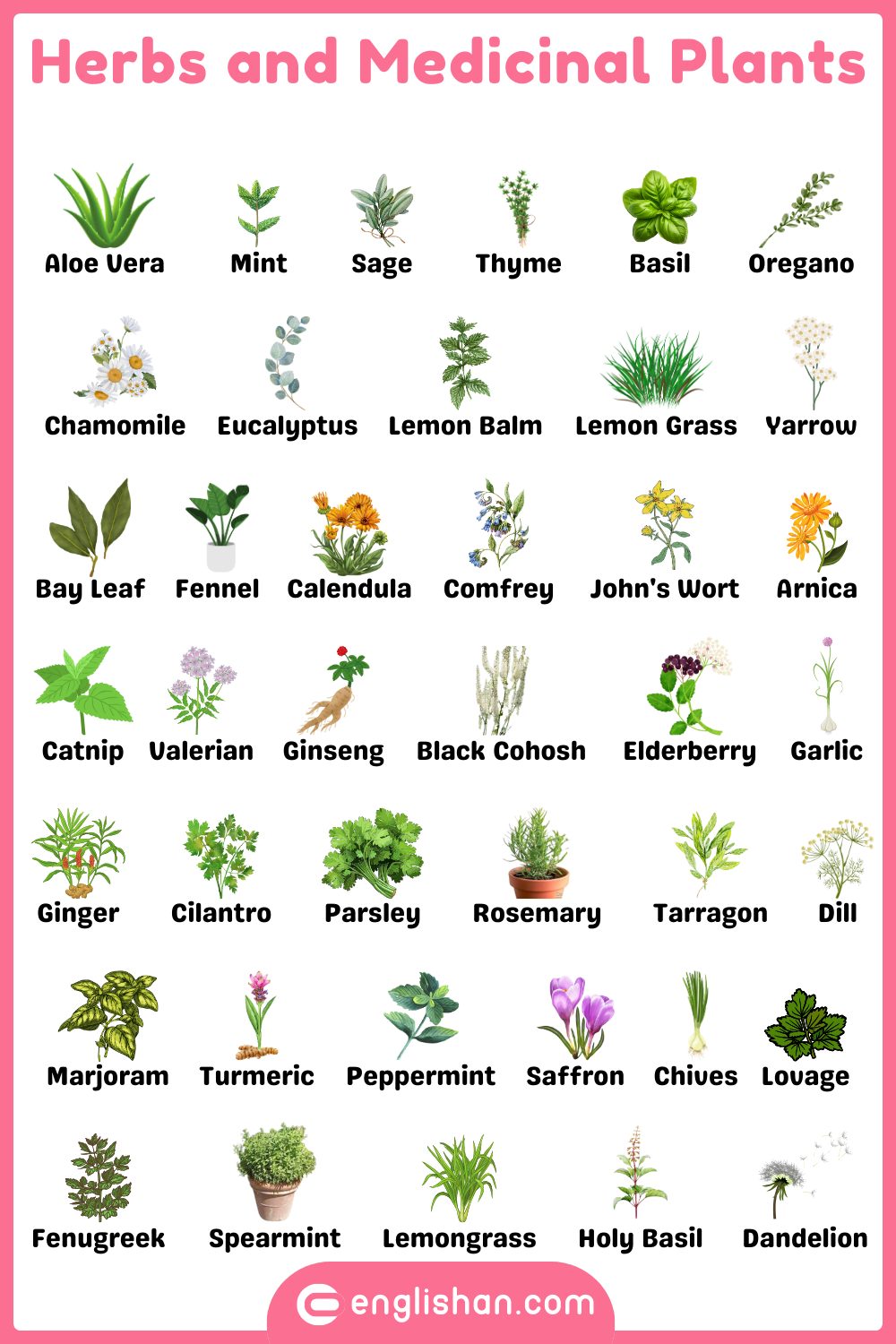
Trees and Shrubs
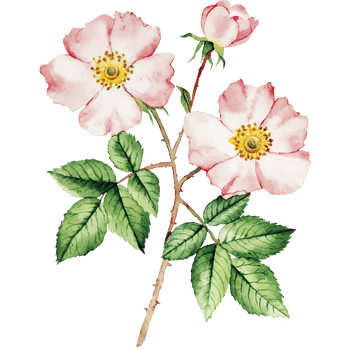
Wild Rose
Wild roses are flowering shrubs that grow up to 3 meters tall. They produce fragrant flowers and rose hips, which are used in herbal teas and skincare for their high vitamin C content.

Western Red Cedar
This large conifer can grow up to 70 meters tall and is known for its durable wood. It’s often used in construction and for making furniture, and its aromatic bark has medicinal uses.

Douglas Fir
A towering evergreen that grows up to 100 meters tall, Douglas fir is known for its strong wood used in construction. It’s also valued as a Christmas tree and for its aromatic resin.

Hemlock
Hemlock trees grow up to 60 meters tall and are known for their soft, feathery foliage. They are commonly used in landscaping and their wood is prized for construction and paper production.

Hemlock
Willows are fast-growing trees that can reach up to 30 meters tall. Known for their graceful, drooping branches, they are often used in landscaping. Willow bark is also valued for its pain-relieving properties.

Aspen
Aspen trees grow up to 25 meters tall and are known for their shimmering leaves that turn golden in autumn. Their wood is used in paper production, and they play an important role in forest ecosystems.

Birch
Birch trees grow up to 20 meters tall and are known for their distinctive white bark. Their wood is often used in furniture-making, and the sap is used in traditional medicine for its detoxifying properties.

Pine
Pine trees are tall evergreens that can grow up to 60 meters tall. Known for their needle-like leaves and cones, they are valued for their wood, which is used in construction and furniture-making.

Spruce
Spruce trees grow up to 60 meters tall and are known for their straight trunks and soft needles. They are often used as Christmas trees and their wood is used in paper production and musical instruments.

Fir
Fir trees are tall evergreens that grow up to 80 meters tall. Known for their symmetrical shape and fragrant needles, they are commonly used as Christmas trees and for their high-quality wood.

Holly
Holly is a shrub or small tree that grows up to 10 meters tall, known for its glossy green leaves and red berries. It’s often associated with Christmas and has symbolic meaning in folklore.

Oak
Oak trees grow up to 40 meters tall and are known for their strength and longevity. Their wood is highly valued in furniture-making and construction, and acorns are an important food source for wildlife.

Maple
Maple trees grow up to 45 meters tall and are famous for their vibrant fall foliage. They are also known for producing maple syrup and have strong wood used in furniture-making.

Ash
Ash trees grow up to 40 meters tall and are known for their strong, flexible wood, often used in tool handles and sports equipment. They are also valued for their medicinal bark.

Beech
Beech trees grow up to 40 meters tall and are known for their smooth, grey bark and dense foliage. Their wood is commonly used in furniture-making, and beech nuts are an important food source for wildlife.

Chestnut
Chestnut trees grow up to 30 meters tall and are known for their edible nuts. Their wood is rot-resistant and is often used in construction and furniture-making.

Walnut
Walnut trees grow up to 30 meters tall and are known for their delicious nuts and high-quality wood, which is often used in furniture and cabinetry. Walnut is also valued in herbal medicine for its anti-inflammatory properties.

Hazelnut
Hazelnut trees grow up to 4 meters tall and are known for their sweet, edible nuts. The tree’s wood is often used for making baskets, and the nuts are a popular ingredient in cooking and confections.

Grapevine
Grapevines are climbing plants that can grow up to 30 meters long, known for producing grapes used in winemaking, juice, and eating. They are widely cultivated for their fruit and leaves, which are also used in cooking.

Cypress
Cypress trees grow up to 40 meters tall and are known for their durable wood, often used in building and making furniture. The tree’s distinctive shape and evergreen foliage make it a popular choice for landscaping.

Sycamore
Sycamore trees grow up to 35 meters tall and are known for their mottled bark and large, broad leaves. They are commonly used in landscaping and their wood is valued for making furniture and musical instruments.

Cherry Blossom
Cherry blossom trees grow up to 12 meters tall and are known for their beautiful pink or white flowers, which bloom in spring. They are highly prized in ornamental gardens and have symbolic meaning in Japanese culture.

Redwood
Redwoods are towering trees that can grow up to 115 meters tall. Known for their thick bark and longevity, they are among the tallest and oldest trees on Earth. Their wood is highly valued for construction.

Linden
Linden trees grow up to 40 meters tall and are known for their fragrant flowers, which are used in herbal teas. The tree’s soft wood is used in carving, and it has a long history of medicinal use.

Ginkgo
Ginkgo trees grow up to 35 meters tall and are known for their fan-shaped leaves and resilience. They are often used in traditional medicine to improve memory and circulation.

Eucalyptus
Eucalyptus trees grow up to 60 meters tall and are known for their fragrant, oil-rich leaves. The oil is widely used for respiratory treatments and in essential oils. The wood is also used in construction and paper making.

Juniper
Juniper is a small coniferous shrub or tree that grows up to 10 meters tall. Known for its berries, which are used to flavor gin and in herbal remedies for digestion and joint pain.

Palm Tree
Palm trees vary in size, growing up to 60 meters tall. They are known for their tall trunks and fan-shaped leaves. Palms are widely cultivated for coconuts, dates, and their ornamental value in tropical regions.

Yew
Yew trees are slow-growing evergreens that can reach up to 20 meters tall. Known for their red berries and dark green needles, yew is often used in landscaping, and its bark is a source of cancer-treating compounds.

Cottonwood
Cottonwoods are fast-growing trees that can reach up to 30 meters tall. Known for their fluffy, cotton-like seeds, they are often found near water and are used in lumber and pulp production.

Alder
Alder trees grow up to 25 meters tall and are known for their ability to thrive in wet conditions. Their wood is used in furniture making, and the bark has traditional medicinal uses for inflammation and wounds.

Hawthorn
Hawthorn is a thorny shrub or small tree that grows up to 10 meters tall, known for its white flowers and red berries. The berries are often used in herbal medicine to support heart health.

Dogwood
Dogwood trees grow up to 12 meters tall and are known for their beautiful white or pink flowers. They are commonly used in landscaping and their bark has traditional medicinal uses for fevers and pain relief.

Bamboo
Bamboo is a fast-growing grass that can reach up to 30 meters tall. Known for its strength and flexibility, bamboo is used in construction, crafts, and as a food source. It symbolizes strength and resilience.

Elder Tree
The elder tree grows up to 9 meters tall and is known for its small white flowers and dark berries, which are used in herbal medicine for boosting the immune system. Elderflowers are also used in skincare and cooking.
Trees and Shrubs Plants in Single Picture
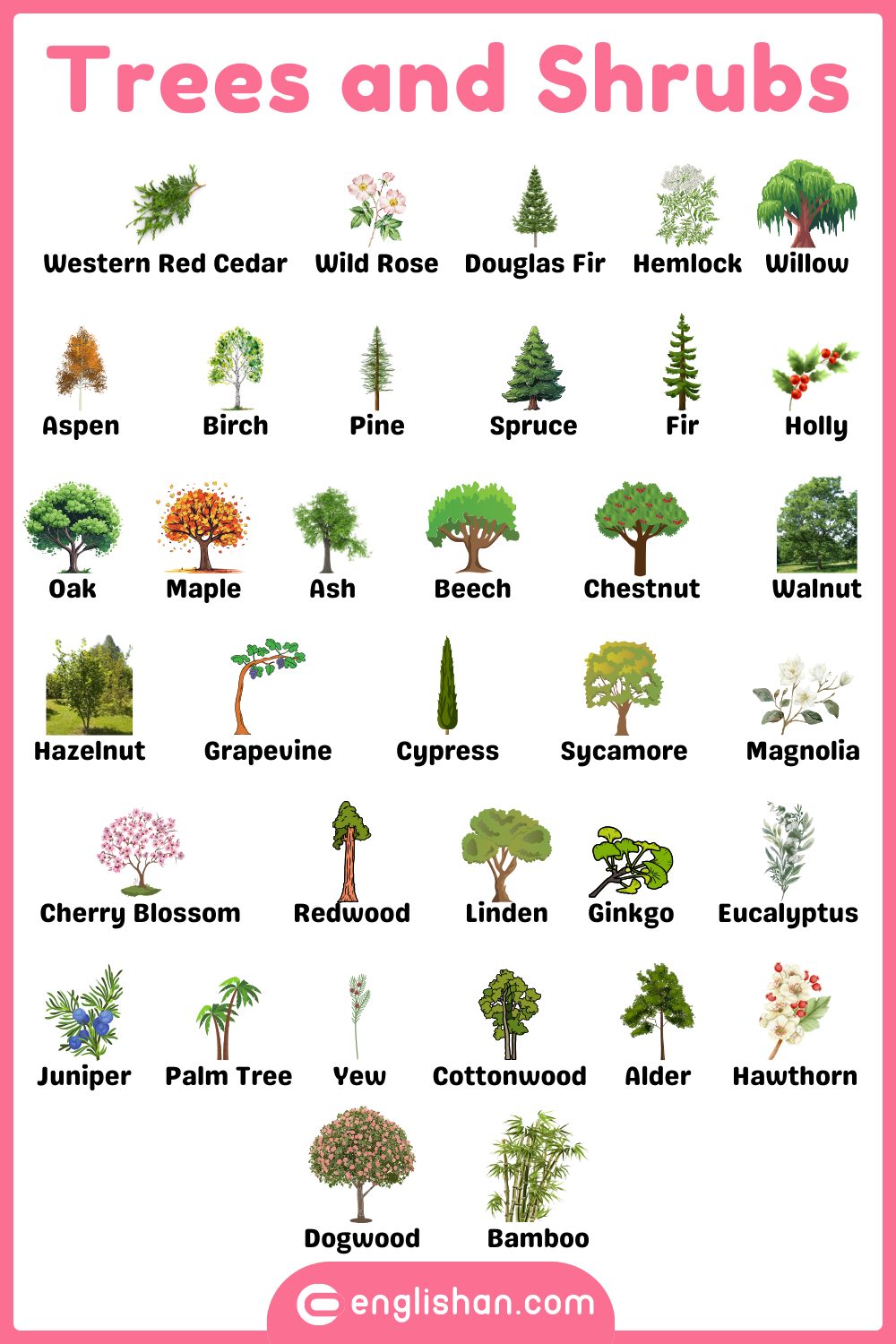
Fruits Plants Names

Strawberry
Strawberry plants grow up to 30 cm tall and produce small, sweet red fruits. Known for their high vitamin C content, they are widely cultivated and used in desserts, jams, and smoothies.

Raspberry
Raspberries grow on thorny bushes that can reach up to 2 meters tall. Known for their sweet-tart flavor, raspberries are rich in antioxidants and used in various culinary dishes and preserves.

Blueberry
Blueberry bushes grow up to 2 meters tall and are known for their small, dark blue fruits. Rich in antioxidants, they are often eaten fresh, used in baking, or made into jams and juices.

Blackberry
Blackberry bushes grow up to 3 meters tall, producing juicy black fruits. They are rich in vitamins and antioxidants, commonly used in jams, pies, and wines. Blackberries grow in wild and cultivated varieties.

Cranberry
Cranberry bushes grow up to 60 cm tall in bogs and produce small, tart red berries. Known for their health benefits, especially in preventing urinary tract infections, cranberries are often used in sauces and juices.

Cherry
Cherry trees grow up to 10 meters tall and are known for their sweet or tart red fruits. Cherries are rich in vitamins and antioxidants, commonly used in pies, jams, and fresh eating.

Apple
Apple trees grow up to 12 meters tall and are known for their crisp, sweet fruits. Apples are one of the most popular fruits worldwide, used in pies, sauces, and fresh for their high vitamin content.

Peach
Peach trees grow up to 8 meters tall and produce soft, juicy fruits with fuzzy skin. Peaches are rich in vitamins and are commonly used in desserts, jams, and fresh eating.

Pear
Pear trees grow up to 12 meters tall and are known for their sweet, juicy fruits. Pears are often eaten fresh or used in desserts and preserves, and they are rich in fiber and vitamins.

Plum
Plum trees grow up to 10 meters tall, producing sweet and tart fruits. Plums are commonly used in desserts, jams, and dried as prunes. They are known for their digestive benefits.

Apricot
Apricot trees grow up to 9 meters tall and produce small, orange fruits. Known for their sweet flavor and high vitamin A content, apricots are used in baking, jams, and fresh eating.

Kiwi
Kiwi plants are vines that grow up to 9 meters long, producing small, fuzzy fruits with green flesh. Known for their high vitamin C content, kiwis are often eaten fresh or used in fruit salads and smoothies.

Banana
Banana plants grow up to 6 meters tall and produce clusters of sweet, yellow fruits. Bananas are rich in potassium and are commonly eaten fresh, used in desserts, or added to smoothies.
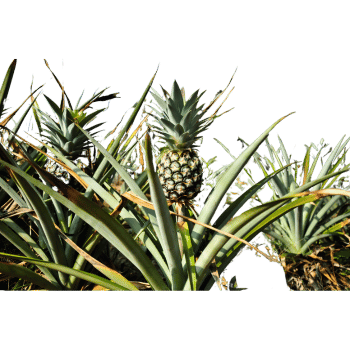
Pineapple
Pineapple plants grow up to 1.5 meters tall and produce large, spiky fruits with sweet, juicy flesh. Known for their vitamin C content, pineapples are often used in cooking, juices, and desserts.

Mango
Mango trees grow up to 30 meters tall and produce sweet, tropical fruits. Mangos are rich in vitamins A and C, and are widely used in fresh eating, smoothies, and desserts.
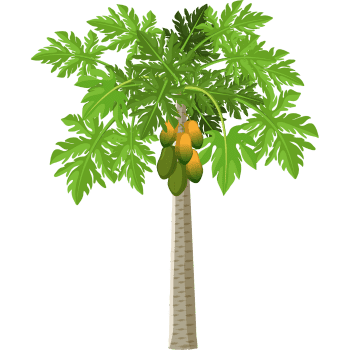
Papaya
Papaya trees grow up to 10 meters tall and produce large, orange fruits. Known for their digestive enzymes, papayas are often eaten fresh, in salads, or used in smoothies.

Avocado
Avocado trees grow up to 20 meters tall, producing creamy fruits high in healthy fats. Avocados are commonly used in salads, sandwiches, and guacamole, and are rich in vitamins and fiber.

Orange
Orange trees grow up to 10 meters tall and are known for their sweet, juicy fruits. Oranges are rich in vitamin C and are commonly eaten fresh, juiced, or used in desserts.

Lemon
Lemon trees grow up to 6 meters tall, producing tart, yellow fruits. Lemons are known for their high vitamin C content and are widely used in cooking, drinks, and natural remedies.

Lime
Lime trees grow up to 5 meters tall and produce small, tart green fruits. Limes are used in cooking, drinks, and as a garnish. They are rich in vitamin C and known for their refreshing flavor.

Grapefruit
Grapefruit trees grow up to 15 meters tall and are known for their large, tart fruits. Grapefruits are rich in vitamin C and are often eaten fresh, juiced, or used in salads.
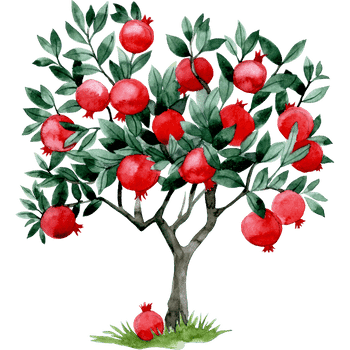
Pomegranate
Pomegranate trees grow up to 10 meters tall and produce round fruits filled with juicy seeds. Pomegranates are rich in antioxidants and are commonly used in juices, salads, and desserts.

Grapes
Grapevines are climbing plants that grow up to 30 meters long, producing small, sweet fruits used in winemaking, fresh eating, and drying as raisins. Grapes are rich in antioxidants and vitamins.

Melon
Melon plants grow as vines, producing large, sweet fruits like cantaloupe and honeydew. Melons are rich in water and vitamins, often eaten fresh or used in salads and desserts.

Fig
Fig trees grow up to 10 meters tall and produce sweet, soft fruits. Figs are commonly eaten fresh or dried and are rich in fiber, vitamins, and minerals. They are also used in jams and desserts.

Watermelon
Watermelon plants grow as sprawling vines and produce large, juicy fruits with sweet red flesh. Watermelons are hydrating and rich in vitamins A and C, commonly eaten fresh or used in salads.

Dragonfruit
Dragonfruit plants, also known as pitaya, grow on climbing cacti and produce brightly colored fruits with a mildly sweet flavor. The fruit is high in antioxidants and vitamins, often eaten fresh or in smoothies.

Lychee
Lychee trees grow up to 12 meters tall and produce small, sweet fruits with a rough, reddish shell. Lychees are rich in vitamin C and are often eaten fresh or used in desserts and beverages.

Passionfruit
Passionfruit plants are climbing vines that produce small, round fruits with a tart, seedy interior. They are high in vitamins and commonly used in drinks, desserts, and sauces.

Mulberry
Mulberry trees grow up to 15 meters tall and produce sweet, blackberry-like fruits. Mulberries are rich in vitamins and antioxidants and are often used in jams, pies, and fresh eating.

Nectarine
Nectarine trees grow up to 7 meters tall and are closely related to peaches, producing smooth-skinned, juicy fruits. They are rich in vitamins A and C and are commonly eaten fresh or used in desserts.
Fruit Plants Names in Single Picture

Vegetables Plants

Tomato
Tomato plants grow as vines up to 3 meters long and produce round, juicy fruits. Tomatoes are widely used in cooking and salads, and are rich in vitamins C and K, as well as antioxidants like lycopene.

Cucumber
Cucumber plants grow as vines, producing long, green fruits with a crisp texture. Cucumbers are refreshing and hydrating, often used in salads, sandwiches, and pickles. They are rich in water and vitamins.

Zucchini
Zucchini plants grow as vines or bushes and produce long, green or yellow fruits. Zucchini is used in a variety of dishes, from soups to baked goods, and is low in calories and rich in vitamins.

Pumpkin
Pumpkin vines can spread up to 10 meters, producing large, orange fruits. Pumpkins are widely used in pies, soups, and as decorations, and their seeds are high in nutrients like magnesium and zinc.

Squash
Squash plants grow as vines or bushes, producing a variety of fruits in different shapes and sizes. Squash is used in cooking and baking, and is rich in vitamins and fiber.

Carrot
Carrot plants grow up to 1 meter tall and produce long, orange roots. Carrots are widely eaten raw, cooked, or in juices, and are rich in beta-carotene, which is converted into vitamin A in the body.

Celery
Celery plants grow up to 60 cm tall, producing long, crisp stalks. Celery is low in calories and commonly used in salads, soups, and snacks. It is known for its high water content and fiber.

Onion
Onion plants grow up to 1 meter tall and produce round, layered bulbs. Onions are a staple in cooking, known for their pungent flavor, and are rich in vitamins and antioxidants.

Garlic
Garlic plants grow up to 60 cm tall and produce bulbous heads divided into cloves. Garlic is widely used for its strong flavor and medicinal properties, particularly in boosting immunity and heart health.

Potato
Potato plants grow up to 1 meter tall and produce starchy tubers. Potatoes are a dietary staple worldwide and are rich in carbohydrates, vitamins, and minerals, used in a wide variety of dishes.

Sweet Potato
Sweet potato plants grow as vines and produce sweet, starchy tubers. Sweet potatoes are rich in fiber, vitamins A and C, and are commonly used in baking, soups, and side dishes.

Spinach
Spinach plants grow up to 30 cm tall and produce tender, dark green leaves. Spinach is a nutrient-rich vegetable, high in iron, calcium, and vitamins A and C, often used in salads, soups, and smoothies.

Lettuce
Lettuce plants grow up to 30 cm tall and produce crisp, leafy heads. Lettuce is commonly used in salads, sandwiches, and wraps, and is low in calories but high in vitamins and water content.

Kale
Kale plants grow up to 1 meter tall and produce dark green, curly leaves. Kale is rich in vitamins A, C, and K, and is commonly used in salads, smoothies, and as a cooked side dish.

Broccoli
Broccoli plants grow up to 1 meter tall and produce large, green flower heads. Broccoli is rich in vitamins, fiber, and antioxidants, commonly used in cooking and as a raw snack.

Cauliflower
Cauliflower plants grow up to 1 meter tall and produce large, white flower heads. Cauliflower is used in a variety of dishes and is rich in vitamins and fiber, often used as a low-carb alternative in cooking.

Peas
Pea plants grow up to 2 meters tall and produce small, sweet pods filled with green peas. Peas are rich in protein and fiber, commonly used in cooking, soups, and as a fresh or frozen vegetable.

Beans
Bean plants grow as bushes or vines, producing pods filled with seeds. Beans are rich in protein and fiber and are widely used in soups, stews, and as a staple food worldwide.

Bell Peppers
Bell pepper plants grow up to 1 meter tall and produce large, sweet fruits in various colors. Bell peppers are rich in vitamins A and C and are used in salads, stir-fries, and grilling.

Eggplant
Eggplant plants grow up to 1.5 meters tall and produce large, glossy purple fruits. Eggplants are used in a variety of dishes, especially in Mediterranean and Asian cuisine, and are rich in fiber and antioxidants.

Beet
Beet plants grow up to 30 cm tall and produce round, sweet roots in shades of red, yellow, or white. Beets are used in salads, juices, and cooking, and are known for their high nutrient and antioxidant content.

Turnip
Turnip plants grow up to 45 cm tall and produce round, white or purple roots. Turnips are commonly used in soups and stews and are rich in fiber, vitamins, and minerals.

Brussels Sprouts
Brussels sprouts grow on tall stalks, reaching up to 1 meter. They produce small, cabbage-like heads that are rich in fiber and vitamins, commonly used roasted or sautéed in dishes.

Leek
Leek plants grow up to 60 cm tall and produce long, white stalks with mild onion flavor. Leeks are commonly used in soups, stews, and quiches, and are rich in vitamins and antioxidants.

Artichoke
Artichoke plants grow up to 1.5 meters tall and produce large, spiky flower buds. The fleshy leaves and hearts are used in cooking and are known for their high antioxidant content.

Asparagus
Asparagus plants grow up to 1.5 meters tall, producing long, green stalks. Asparagus is rich in vitamins and is commonly used in salads, stir-fries, and grilled dishes.

Okra
Okra plants grow up to 2 meters tall and produce long, green pods. Okra is commonly used in soups, stews, and fried dishes, and is known for its high fiber content and mucilaginous texture.

Fennel
Fennel plants grow up to 2 meters tall, producing bulbous white stems and feathery leaves. Fennel is used in cooking for its sweet, anise-like flavor and is rich in fiber and vitamins.

Swiss Chard
Swiss chard grows up to 60 cm tall and produces colorful, leafy greens. It’s rich in vitamins A and C and is commonly used in salads, stir-fries, and soups.

Rhubarb
Rhubarb plants grow up to 1 meter tall and produce long, tart stalks. The stalks are commonly used in pies, jams, and desserts, while the leaves are toxic and should not be consumed.

Scallions
Scallions, also known as green onions, grow up to 50 cm tall and produce long, thin stalks with a mild onion flavor. They are commonly used as a garnish or in salads and soups.
Vegetable Plants Names in Single Picture

Grains Plants Names

Corn
Corn plants grow up to 3 meters tall and produce ears filled with sweet, edible kernels. Corn is a staple food worldwide, used fresh, dried, or ground into flour, and is rich in carbohydrates and fiber.

Wheat
Wheat plants grow up to 1.5 meters tall and produce grain used in bread, pasta, and other foods. Wheat is a major source of carbohydrates and is rich in fiber and essential nutrients.

Barley
Barley plants grow up to 1 meter tall and produce grain used in soups, stews, and brewing beer. Barley is a rich source of fiber and essential nutrients.

Rye
Rye plants grow up to 2 meters tall and produce grain used in bread, beer, and whiskey production. Rye is known for its hearty flavor and high fiber content.

Quinoa
Quinoa plants grow up to 2 meters tall and produce small, edible seeds that are a complete source of protein. Quinoa is commonly used in salads, soups, and as a rice substitute.

Oats
Oat plants grow up to 1.5 meters tall and produce grain used in cereals, porridge, and baking. Oats are rich in fiber and known for their heart-healthy benefits.

Rice
Rice plants grow up to 1.5 meters tall and are cultivated for their edible grains, a staple food in many cultures. Rice is rich in carbohydrates and is used in a wide variety of dishes.

Sorghum
Sorghum plants grow up to 4 meters tall and produce grain used in porridge, bread, and beverages. Sorghum is drought-resistant and rich in protein and fiber.

Millet
Millet plants grow up to 1 meter tall and produce small, edible seeds used in porridges, bread, and brewing. Millet is rich in fiber and a good source of essential minerals.

Buckwheat
Buckwheat plants grow up to 1 meter tall and produce triangular seeds used in pancakes, noodles, and porridge. Buckwheat is gluten-free and rich in fiber and protein.

Spelt
Spelt is an ancient grain that grows up to 1.5 meters tall and is used in bread, pasta, and cereals. It’s known for its nutty flavor and high fiber content.

Teff
Teff plants grow up to 1 meter tall and produce tiny grains used in flatbreads and porridges. Teff is a gluten-free grain and is rich in protein, fiber, and iron.

Farro
Farro is an ancient grain that grows up to 1.5 meters tall, commonly used in soups, salads, and bread. It’s high in fiber, protein, and essential minerals.

Amaranth
Amaranth plants grow up to 2 meters tall and produce small seeds used in cereals and baked goods. Amaranth is rich in protein and fiber and is gluten-free.

Triticale
Triticale is a hybrid of wheat and rye that grows up to 1.5 meters tall. It’s used in bread and cereals and is valued for its high yield and nutritional content.

Kamut
Kamut is an ancient wheat variety that grows up to 2 meters tall. Known for its large kernels, it’s used in baking and is rich in protein and essential minerals.

Emmer
Emmer, also known as farro, grows up to 1.5 meters tall and produces grains used in salads, soups, and breads. It’s an ancient grain high in fiber and protein.

Freekeh
Freekeh is an ancient grain made from roasted green wheat and is known for its nutty flavor. It’s used in salads, soups, and stews and is rich in fiber and protein.
Grains Plant Names in Single Picture

Legumes Plants Names

Lentils
Lentil plants grow up to 40 cm tall and produce small, lens-shaped seeds. Lentils are rich in protein, fiber, and iron, and are commonly used in soups, stews, and salads.

Chickpeas
Chickpea plants grow up to 1 meter tall and produce round, beige seeds. Chickpeas are widely used in hummus, salads, and stews, and are rich in protein, fiber, and essential minerals.

Soybeans
Soybean plants grow up to 1 meter tall and produce small, green or yellow seeds. Soybeans are used to make tofu, soy milk, and other products, and are a rich source of plant-based protein.

Black Beans
Black bean plants grow as bushes or vines, producing small, shiny black seeds. Black beans are rich in protein and fiber, commonly used in Latin American cuisine.

Kidney Beans
Kidney bean plants grow up to 60 cm tall and produce large, red beans. They are commonly used in soups, stews, and chili, and are rich in protein and fiber.

Pinto Beans
Pinto bean plants grow up to 60 cm tall, producing speckled beans. They are commonly used in refried beans and stews, and are rich in protein, fiber, and vitamins.

Navy Beans
Navy bean plants grow up to 50 cm tall and produce small, white beans. Navy beans are commonly used in soups and baked bean dishes and are rich in protein and fiber.

Lima Beans
Lima bean plants grow up to 1 meter tall and produce large, flat beans. Lima beans are used in soups, stews, and side dishes and are rich in protein and fiber.

Green Beans
Green bean plants grow as bushes or vines, producing long, green pods. Green beans are commonly eaten fresh, steamed, or sautéed and are rich in fiber and vitamins.

Fava Beans
Fava bean plants grow up to 1.8 meters tall and produce large, flat beans. They are used in Mediterranean and Middle Eastern dishes and are rich in protein and fiber.

Adzuki Beans
Adzuki bean plants grow up to 60 cm tall and produce small, red beans. Adzuki beans are commonly used in Asian desserts and are rich in protein and antioxidants.

Mung Beans
Mung bean plants grow up to 60 cm tall and produce small, green beans. Mung beans are commonly used in Asian cuisine, often sprouted or made into soups and desserts.

Split Peas
Split pea plants grow up to 1 meter tall, producing dried peas that are split for cooking. Split peas are commonly used in soups and are rich in protein and fiber.

Black-Eyed Peas
Black-eyed pea plants grow up to 60 cm tall and produce small, cream-colored beans with a black spot. They are rich in protein and fiber and commonly used in Southern cuisine.

Peanuts
Peanut plants grow up to 50 cm tall and produce underground pods containing nuts. Peanuts are used in snacks, peanut butter, and cooking, and are rich in protein and healthy fats.

Garbanzo Beans
Also known as chickpeas, garbanzo beans grow up to 1 meter tall and are rich in protein and fiber. They are used in a variety of dishes such as hummus, stews, and salads.
Legumes Plant Names in Single Picture

Nuts Plants Names in English

Almond
Almond trees grow up to 10 meters tall and produce edible seeds. Almonds are widely used in baking, snacking, and as almond milk, and are rich in healthy fats and vitamin E.
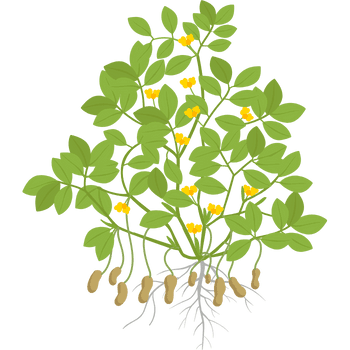
Peanut
Peanut plants grow up to 50 cm tall, producing nuts underground. Peanuts are rich in protein and healthy fats and are used in snacks, cooking, and peanut butter.

Cashew
Cashew trees grow up to 14 meters tall and produce kidney-shaped nuts. Cashews are used in cooking, snacks, and dairy alternatives like cashew milk, and are rich in healthy fats.

Pistachio
Pistachio trees grow up to 10 meters tall and produce small, green nuts. Pistachios are commonly eaten as a snack and are rich in protein, healthy fats, and antioxidants.

Walnut
Walnut trees grow up to 30 meters tall, producing hard-shelled nuts. Walnuts are used in baking, salads, and snacking, and are rich in omega-3 fatty acids and antioxidants.
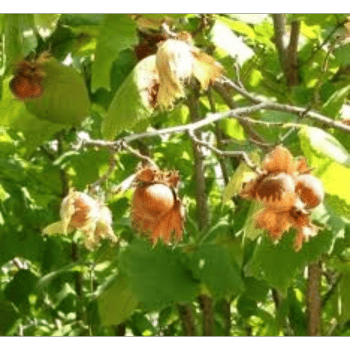
Hazelnut
Hazelnut trees grow up to 4 meters tall, producing small, sweet nuts. Hazelnuts are commonly used in confections, snacks, and baking, and are rich in healthy fats and vitamins.

Brazil Nut
Brazil nut trees grow up to 50 meters tall, producing large, hard-shelled nuts. Brazil nuts are rich in selenium and healthy fats, and are often eaten as a snack or used in cooking.
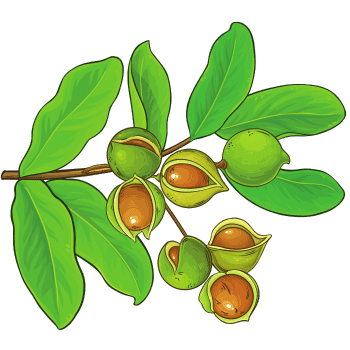
Macadamia Nut
Macadamia trees grow up to 15 meters tall and produce rich, buttery nuts. Macadamia nuts are commonly used in baking and snacking and are high in healthy fats and antioxidants.

Pecan
Pecan trees grow up to 30 meters tall, producing smooth-shelled nuts. Pecans are commonly used in pies, baking, and snacking, and are rich in healthy fats and fiber.

Chestnut
Chestnut trees grow up to 30 meters tall, producing large, starchy nuts. Chestnuts are often roasted or used in baking, and are lower in fat compared to other nuts.
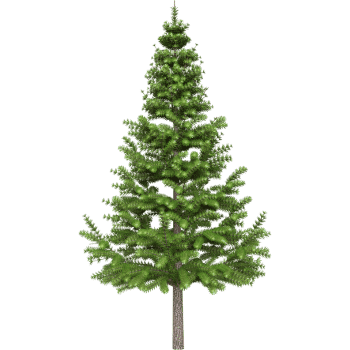
Pine Nuts
Pine trees produce small, edible seeds known as pine nuts. Pine nuts are commonly used in pesto, salads, and baking, and are rich in healthy fats and protein.

Hickory Nuts
Hickory trees grow up to 30 meters tall and produce hard-shelled nuts. Hickory nuts are commonly eaten raw or used in baking, and are rich in healthy fats and fiber.
Nuts Plant Names in Single Picture

Seeds Plants

Sunflower Plant
Sunflower plants grow up to 3 meters tall and produce large flower heads filled with seeds. Sunflower seeds are commonly eaten as a snack or used in cooking and are rich in healthy fats and vitamin E.

Chia Plant
Chia plants grow up to 1 meter tall and produce tiny, nutrient-dense seeds. Chia seeds are commonly used in smoothies, puddings, and baked goods, and are rich in omega-3 fatty acids, fiber, and protein.
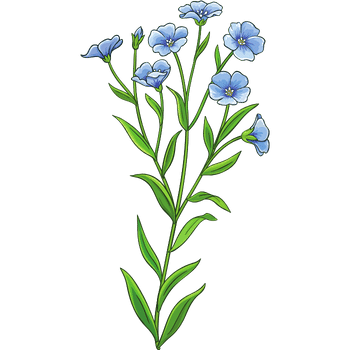
Flax Plant
Flax plants grow up to 1.2 meters tall and produce small, golden or brown seeds. Flax seeds are used in baking, smoothies, and cereals, and are rich in omega-3 fatty acids and fiber.
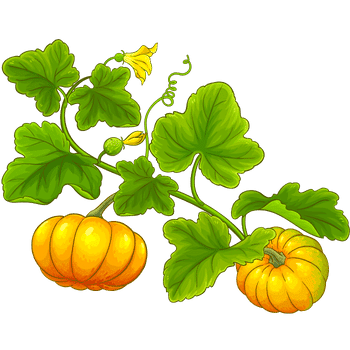
Pumpkin Plant
Pumpkin plants grow as vines, producing large fruits filled with edible seeds. Pumpkin seeds, or pepitas, are often eaten as a snack and are rich in magnesium, zinc, and healthy fats.
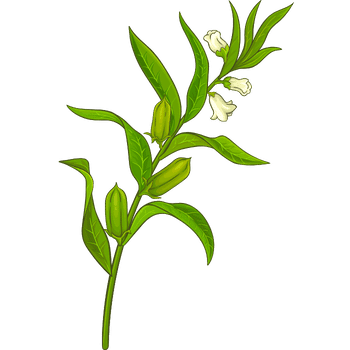
Sesame Plant
Sesame plants grow up to 1 meter tall and produce small, oil-rich seeds. Sesame seeds are used in cooking, especially in Middle Eastern and Asian cuisine, and are rich in healthy fats and minerals.

Hemp Plant
Hemp plants grow up to 4 meters tall and produce small, nutrient-dense seeds. Hemp seeds are used in smoothies, salads, and baking, and are rich in protein, omega-3 fatty acids, and fiber.

Poppy Plant
Poppy plants grow up to 1 meter tall and produce tiny seeds used in baking and cooking. Poppy seeds are rich in calcium, magnesium, and dietary fiber, often found in breads and pastries.

Mustard Plant
Mustard plants grow up to 1 meter tall and produce small seeds used to make mustard and in cooking. Mustard seeds are rich in essential oils and are used in seasoning and sauces.
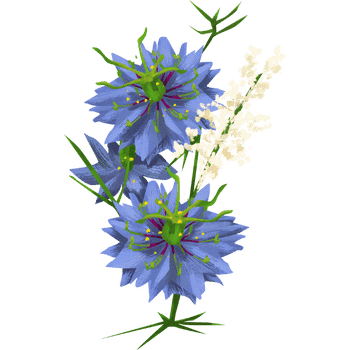
Cumin Plant
Cumin plants grow up to 30 cm tall and produce small, crescent-shaped seeds. Cumin seeds are commonly used in spice blends and cooking, and are known for their earthy, warm flavor.
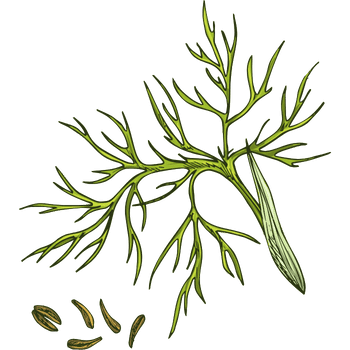
Caraway Plant
Caraway plants grow up to 60 cm tall and produce small seeds with a slightly anise-like flavor. Caraway seeds are commonly used in bread, soups, and sausages and are known for their digestive benefits.
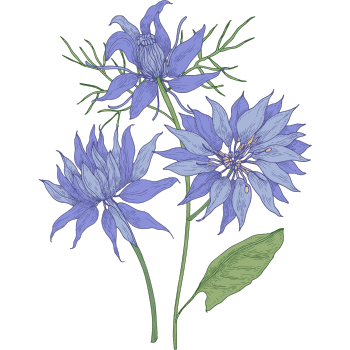
Nigella Plant
Nigella plants grow up to 60 cm tall and produce small, black seeds with a peppery flavor. Nigella seeds are commonly used in Middle Eastern and Indian cuisine and are rich in antioxidants.
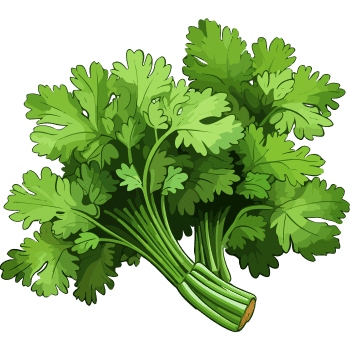
Coriander Plant
Coriander plants grow up to 50 cm tall and produce small, round seeds. Coriander seeds are used in cooking and spice blends and are known for their warm, citrusy flavor.

Fennel Plant
Fennel plants grow up to 2 meters tall and produce small, anise-flavored seeds. Fennel seeds are used in cooking, teas, and traditional medicine, especially for digestive health.
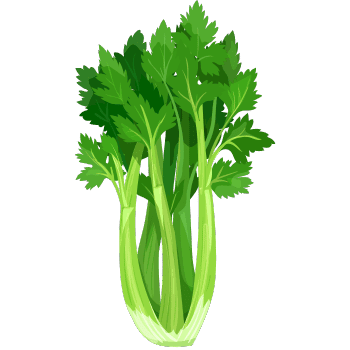
Celery Plant
Celery plants grow up to 60 cm tall and produce tiny seeds used in seasoning and spice blends. Celery seeds are commonly used in pickling and soups and are rich in antioxidants.
Succulents and Cacti Plants

Aloe Vera
Aloe vera is a succulent that grows up to 100 cm tall, known for its thick, fleshy leaves filled with a soothing gel. Aloe vera is used in skin care, burns, and digestive health.

Jade Plant
Jade plants are succulents that grow up to 1.2 meters tall and are known for their thick, round leaves. They are often grown as indoor plants and are believed to bring good luck.

Echeveria
Echeveria is a small succulent that grows up to 20 cm tall, known for its rosette-shaped leaves. It is commonly grown as a decorative plant and requires little water, making it easy to care for.

Agave
Agave plants grow up to 2 meters tall and are known for their sharp, spiky leaves. They are used to produce agave syrup and tequila, and their fibers are used for making rope and textiles.

Prickly Pear Cactus
Prickly pear cacti grow up to 5 meters tall and are known for their flat, paddle-like segments and edible fruits. The fruits are commonly used in jellies and drinks, while the pads are used in cooking.

Saguaro Cactus
Saguaro cacti are towering desert plants that can grow up to 12 meters tall. They are iconic symbols of the American Southwest and are known for their large size and slow growth.

Barrel Cactus
Barrel cacti grow up to 1 meter tall and are known for their round, ribbed shape and large, sharp spines. They are commonly found in deserts and are sometimes used as emergency water sources.

Christmas Cactus
Christmas cactus is a popular indoor plant that grows up to 30 cm tall and produces bright, colorful flowers during the winter. It is easy to care for and is often given as a holiday gift.

Zebra Plant
Zebra plants are small succulents that grow up to 15 cm tall, known for their distinctive striped leaves. They are commonly grown indoors as decorative plants due to their striking appearance.

Sedum
Sedum plants, also known as stonecrop, grow up to 60 cm tall and are known for their thick, fleshy leaves. Sedum is often used in rock gardens and requires little water, making it drought-resistant.

Haworthia
Haworthia plants are small succulents that grow up to 15 cm tall, known for their fleshy, spiky leaves. They are often grown indoors and are prized for their easy care and attractive appearance.

Hens and Chicks
Hens and chicks are small, rosette-shaped succulents that grow up to 20 cm tall. They are known for their ability to propagate easily, with the “hen” producing “chicks” or small offshoots.
Succulents and Cacti Plants in Single Picture

In order to learn more about plants you might want to read Plants Parts Names
All Plants Names with Pictures – At a Glance
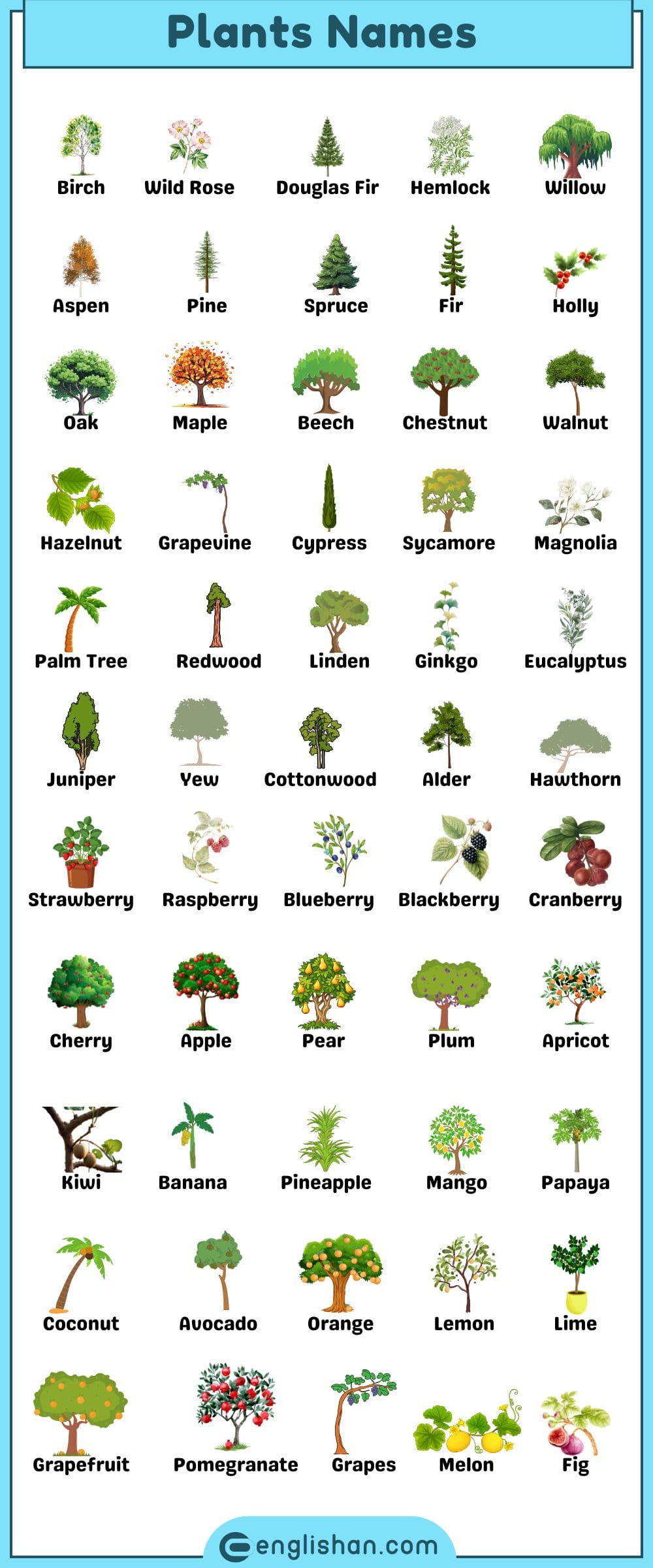

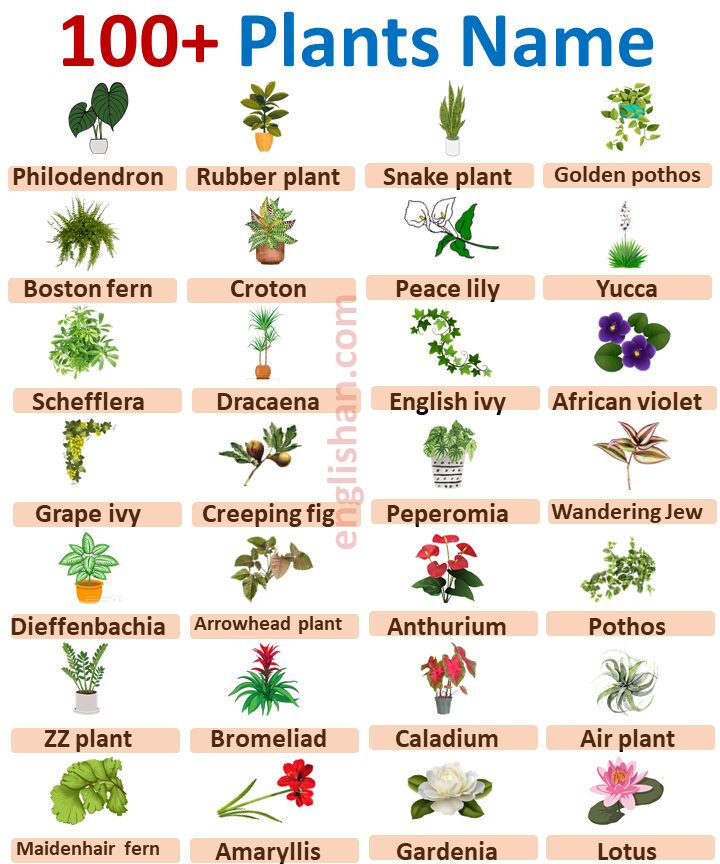
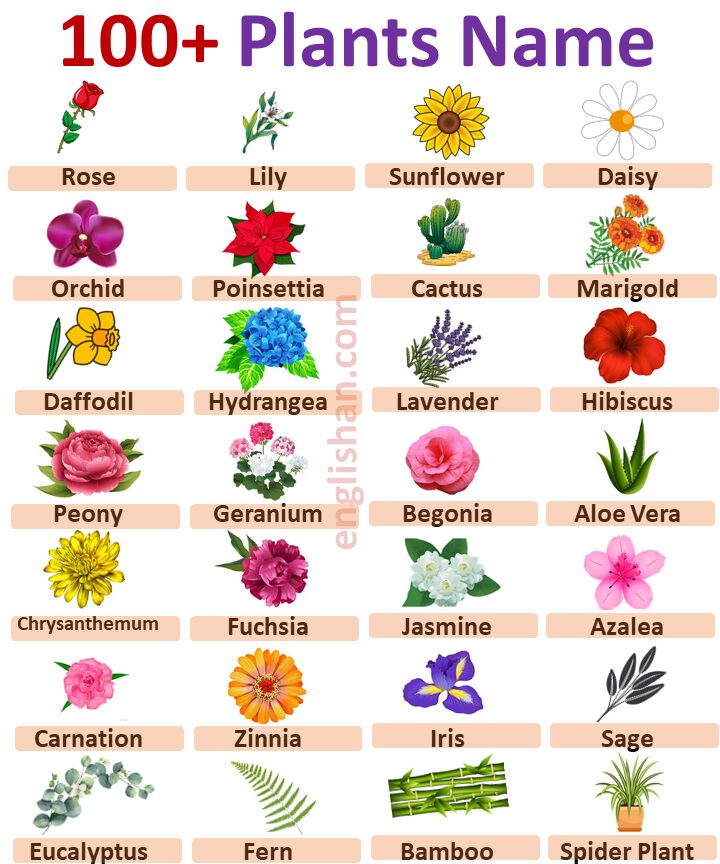
FAQs:
Here are the names of 10 plants:
1. Rose
2. Tulip
3. Oak
4. Cactus
5. Sunflower
6. Lavender
7. Bamboo
8. Daisy
9. Mint
10. Violet
These are common and well-known plants!
Here are 5 types of plants:
1. Trees – Tall plants with a trunk.
Example: Oak.
2. Shrubs – Small, bushy plants.
Example: Rose.
3. Herbs – Small plants used for food or medicine.
Example: Mint.
4. Climbers – Plants that grow by climbing.
Example: Ivy.
5. Aquatic Plants – Plants that grow in water.
Example: Lily.
These are different types of plants you can find!
A common name plant is the everyday name people use for a plant.
For example:
Rose
Sunflower
These names are simple and easy to remember, unlike scientific names which are longer and harder to say.
The 4 main types of plants are:
1. Trees – Tall plants with a single trunk.
Example: Oak
2. Shrubs – Small, bushy plants with many stems.
Example: Rose
3. Herbs – Small plants used for food or medicine.
Example: Mint
4. Grasses – Plants with long, thin leaves.
Example: Wheat
You May Also Like




